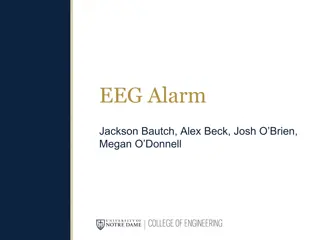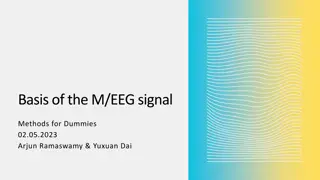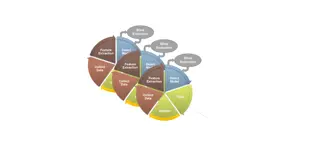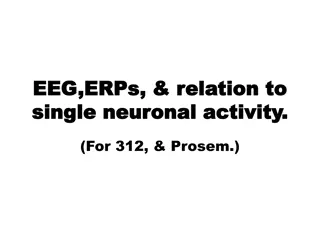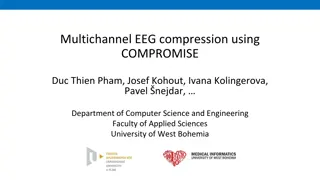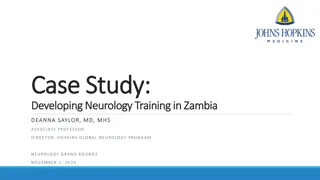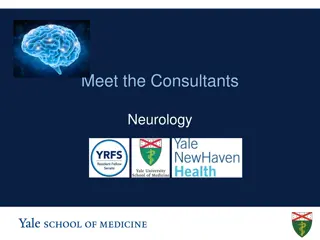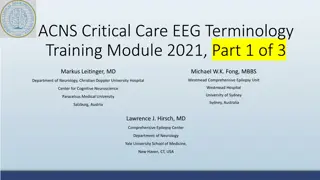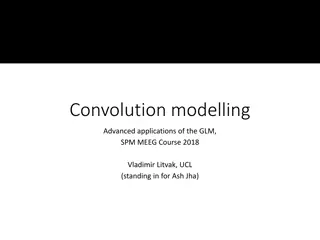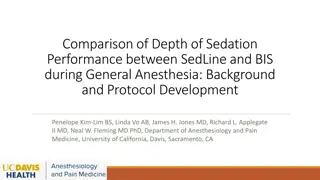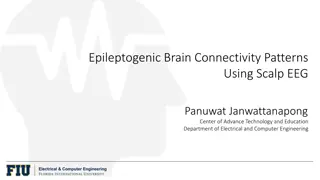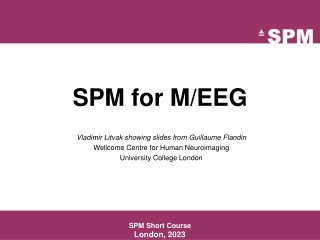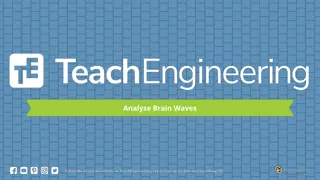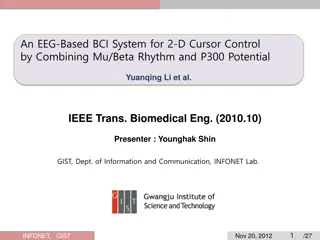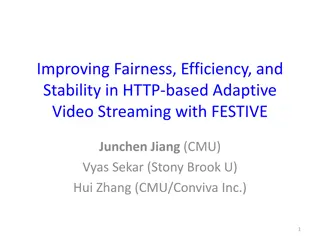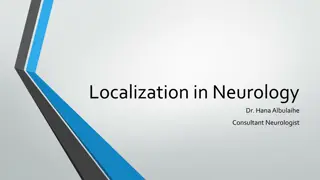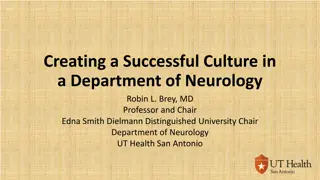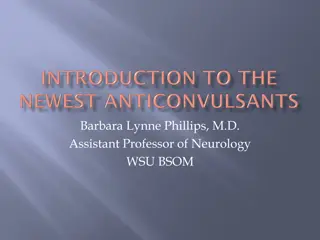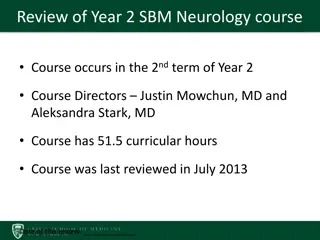Understanding Video-EEG Monitoring in Neurology
Detailed information on the uses, options, and activation procedures for Video-EEG monitoring in neurology, focusing on diagnosis, interictal epileptiform discharges, medication adjustment, and surgical candidacy evaluation. Learn about the yield of EEG monitoring, methods to increase yield, and different types of EEG monitoring available for outpatient and inpatient settings.
Download Presentation

Please find below an Image/Link to download the presentation.
The content on the website is provided AS IS for your information and personal use only. It may not be sold, licensed, or shared on other websites without obtaining consent from the author. Download presentation by click this link. If you encounter any issues during the download, it is possible that the publisher has removed the file from their server.
E N D
Presentation Transcript
AMBULATORY AND VIDEO EEG Amar B. Bhatt, MD, FAES Assistant Professor of Neurology, Epilepsy Section Rush University Medical Center
DISCLOSURES Disclosure of Financial Relationships None Off-Label Usage None
Objectives Uses of video-EEG monitoring Options for EEG monitoring Yield of EEG monitoring Activation procedures used to increase yield Comparison of different types of EEG monitoring
Uses of Video-EEG monitoring Diagnosis (epileptic vs. non-epileptic) Interictal Epileptiform Discharges Classification and Localization Medication Adjustment Seizure / Discharge Quantification Surgical Candidacy Evaluation
Options for EEG monitoring Short-term inpatient or outpatient Routine video-EEG (20-60 min) Prolonged/Extended video-EEG (1-4 hours) Long-term outpatient Ambulatory EEG Home video-EEG a growing trend Long-term inpatient Portable continuous video-EEG (usu. ICU) a.k.a. cEEG* Hard-wired continuous video-EEG (usu. Epilepsy Monitoring Unit) a.k.a. EMU* *some ICUs are hard-wired, some EMUs are portable
What is the typical yield of a routine outpatient EEG study in adults? (chance of capturing an epileptiform abnormality in a patient with suspected epilepsy) A. 25% B. 33% C. 50% D. 66% E. 80%
Methods of increasing EEG Yield Single routine EEG: 40-50% yield* in epileptic patients Repeat and 2-4 hour extended EEGs increase yield* to 80-90% Remaining Cases: Long-term monitoring (cEEG, EMU, Ambulatory EEG) *this yield is for interictal epileptiform discharges (not diagnostic of epilepsy)
Activating Procedures Hyperventilation and Photic Stimulation Mostly for generalized epilepsies Lack of slow activity or driving still normal Drowsiness and Sleep
Harmonic driving Driving response that is a multiple or factor of the flash frequency Can be half, double, triple, etc. Can have a notched appearance (multiple fused frequencies)
Which of the following responses is abnormal during photic stimulation? A. Photoconvulsive response B. Photomyogenic response C. Photomyoclonic response D. Photovoltaic response E. Photocell response
Photoparoxysmal response a.k.a. photoconvulsive response* Assoc. with generalized epilepsy Usu. generalized / bifrontally predominant May be bioccipitally predominant May have assoc. absence, myoclonic, or generalized tonic clonic (GTC) seizures Assoc. with occipital epilepsy if unilateral (rare) *controversial: some say photoconvulsive implies that discharges outlast the flash
Photomyogenic response a.k.a. photomyoclonic response this is benign don t let myoclonic fool you EMG potentials (frontal) time-locked to the flash frequency
Photovoltaic (photocell) artifact high impedance electrode creates a cell or battery capable of storing charge released with each photic flash, resulting in a time locked spiky response on EEG only specifically in the electrode with the high impedance.
Normal impedance: 0.1 to 5 kOhms (100 5000 ?)
Ambulatory EEG Home-based EEG recording May have a daily patient visit to fix electrodes and download data Patient must push button or record in diary Cheaper and more widely available than EMU
Ambulatory EEG Uses Event capture yield is 40-70% Interictal yield 48 hours captures 95% of such patients Nocturnal disorders (frontal seizures, sleep disorders, ESES/CSWS) Quantifying subclinical / subtle clinical seizures Determining recurrence risk when considering seizure medication withdrawal Faulkner et al, Clin Neurophysiol, 2012; Lawley et al, Epilepsy and Behavior, 2015
Ambulatory EEG Advantages minimal interference with patient activities natural environment to trigger events/seizures Disadvantages prone to artifacts no video or real-time monitoring (in most cases) cannot examine patient during event cannot safely withdraw medications
Importance of Video Semiology analysis Correlation to patient / witness history Assessment for artifact Diagnosis (esp. when EEG is normal)
Long-term video-EEG monitoring EMU remains the diagnostic gold standard Ideally requires: Ictal EEG, video, and exam Interictal EEG recording with med withdrawal Correlation to history (confirm all of patient s full blown and typical event types were captured)
Long-term video-EEG monitoring Advantages invasive monitoring ictal functional imaging medication adjustment Disadvantages high cost (techs, nursing, physicians, hospital) disrupts patient s normal activities and work/school risk of nosocomial infections risk of physical and psychological harm/injury
Refer refractory cases! Why? To confirm diagnosis of epilepsy For alternative treatment options (surgery, etc.) To avoid inappropriate treatments What defines refractory? Lack of seizure control with two properly dosed medications NOT failed due to side effects
A 28-year-old man develops new onset partial seizures. Treatment with levetiracetam is initiated, and the dose is titrated up to 1500 mg twice daily without seizure recurrence. However, he does not tolerate this medication due to worsening depression. The medication is tapered off and lamotrigine is titrated upward. What is the patient s chance of seizure freedom with lamotrigine? A. ~75% B. ~66% C. ~50% D. ~33% E. ~15%
Chances of Seizure Freedom refractory 36% first drug 47% multiple drugs 3% second drug 13% third drug 1% Seizure-free with surgery (in the right cases): up to 70% Kwan and Brodie, NEJM, 2000. Chen, Brodie, Liew, and Kwan, JAMA Neurology, 2018.
In a patient with epilepsy, how many medications should be failed due to lack of seizure control prior to considering referral to an epilepsy center (or epilepsy monitoring unit)? A. One B. Two C. Three D. Four E. Five
Unnecessary VNS in PNES 60 consecutive VNS patients in EMU 13 had PNES exclusively (none had prior EMU) all on 2-4 medications all discharged off medications duration of VNS therapy: 0.5 5 yrs mean latency to PNES diagnosis: 2.8 yrs Over-interpretation of outpatient EEGs? Arain et al, Epilepsy and Behavior, 2011
Diagnostic usefulness and duration of the inpatient long-term video-EEG monitoring 234 consecutive LTM studies over 2 yrs (221 patients) Diagnostically useful in 44% (typical event previously not captured) Not different between age groups Not different between referral groups [diagnostic (41%), classification (41%) and presurgical (55%)] Duration of successful LTM significantly longer in the presurgical group (mean: 3.5 days) vs. diagnostic and classification groups (2.4 and 2.3 days, respectively) Alving and Beniczky, Seizure, 2009 courtesy of Dr. Abou-Khalil
What is the typical diagnostic yield (chance of capturing a patient s typical events) during epilepsy monitoring unit (EMU) admission? A. 20-25% B. 40-45% C. 60-65% D. 80-85% E. 90-95%
Non-diagnostic EMU studies Diagnostic yield of 1st EMU study: 82-85% Diagnostic yield of 2nd EMU study: 42-53% Factors associated with non-diagnostic study: younger age (in adults) longer duration of monitoring normal outpatient EEG absence of epilepsy risk factors Elgavish and Cabaniss, J Clin Neurophysiol, 2011: ~3600 patients Robinson et al, Epilepsy and Behavior, 2011: ~2400 patients
Co-existent epilepsy and PNES Occurrence has decreased historically possibly due to wider use of video-EEG monitoring estimated to be 5-15% Key factors in successful monitoring duration (5 days suggested as optimal*) Seizure medication withdrawal capture of all typical event types *Foong and Seneviratne, J Clin Neurosci, 2016
Continuous EEG (cEEG) in the ICU Non-convulsive seizures / status epilepticus have a typical combined incidence of 20-25% May vary (8-48%) depending on the study 40-92% of seizures on cEEG are nonconvulsive
NCS/NCSE: When to consider cEEG Altered mental status (esp. unexplained) History of epilepsy or recent seizures (esp. GTCS) Subtle twitching, eye deviation, nystagmus Recent CNS procedure, infections, stroke, neoplasms (esp. when pt is worse than expected) Chronic focal cortical injury
In critically ill, non-comatose patients undergoing continuous EEG monitoring, what duration of monitoring is recommended to capture a seizure in the majority (95%) of patients who will develop seizures in the ICU? A. 1 hour B. 6 hours C. 12 hours D. 24 hours E. 48 hours
Continuous EEG in critically ill patients 570 patients with altered mental status Longer cEEG duration required in comatose patients To capture most seizures: Noncomatose 24 hrs Comatose 48 hrs Claassen et al., Neurology 2004;62:1743 8.
Routine EEG Extended EEG Continuous portable EEG Long-term EEG (EMU) Ambulatory EEG Home vEEG Availability + + - - + -- Duration -- - ++ ++ + + Video + + + + - + Ictal EEG -- - + ++ + + Examination + + - ++ -- -- EEG quality + + + ++ - + Surgery - - + ++ - - Natural environment - - - - + + Acute use + + ++ + -- -- Med change - - + ++ - - Hx correlate - - + ++ - - Quantify sz - + ++ ++ + + Sleep EEG - + ++ ++ ++ ++ HV/Photic + + + + - - Affordability ++ + -- -- + -
References Alving J, Beniczky S. Diagnostic usefulness and duration of the inpatient long-term video-EEG monitoring: findings in patients extensively investigated before the monitoring. Seizure. 2009 Sep;18(7):470-3. doi: 10.1016/j.seizure.2009.04.005. Epub 2009 May 9. PubMed PMID: 19428271 Arain AM, Song Y, Bangalore-Vittal N, Ali S, Jabeen S, Azar NJ. Long term video/EEG prevents unnecessary vagus nerve stimulator implantation in patients with psychogenic nonepileptic seizures. Epilepsy Behav. 2011 Aug;21(4):364-6. Cascino GD. Video-EEG monitoring in adults. Epilepsia. 2002;43 Suppl 3:80-93. Review. PubMed PMID: 12060010. Chen Z, Brodie MJ, Liew D, Kwan P. Treatment outcomes in patients with newly diagnosed epilepsy treated with established and new antiepileptic drugs: a 30-year longitudinal cohort study. JAMA neurology. 2018 Mar 1;75(3):279-86. Claassen J, Mayer SA, Kowalski RG, Emerson RG, Hirsch LJ. Detection of electrographic seizures with continuous EEG monitoring in critically ill patients. Neurology. 2004 May 25;62(10):1743-8. Review. PubMed PMID: 15159471. Elgavish RA, Cabaniss WW. What is the diagnostic value of repeating a nondiagnostic video-EEG study? J Clin Neurophysiol. 2011 Jun;28(3):311-3. doi: 10.1097/WNP.0b013e31821c3aa9. PubMed PMID: 21633258. Faulkner HJ, Arima H, Mohamed A. Latency to first interictal epileptiform discharge in epilepsy with outpatient ambulatory EEG. Clin Neurophysiol.2012-123(9):1732-1735. doi:10.1016/.clinph.2012.01.023 Foong M, Seneviratne U. Optimal duration of video-electroencephalographic monitoring to capture seizures. J Clin Neurosci. 2016 Jun;28:55-60. doi: 10.1016/j.jocn.2015.10.032. Epub 2016 Mar 5. PubMed PMID: 26960265. Khan OI, Azevedo CJ, Hartshorn AL, Montanye JT, Gonzalez JC, Natola MA, Surgenor SD, Morse RP, Nordgren RE, Bujarski KA, Holmes GL, Jobst BC, Scott RC, Thadani VM. A comparison of continuous video-EEG monitoring and 30-minute EEG in an ICU. Epileptic Disord. 2014 Dec;16(4):439-48. doi: 10.1684/epd.2014.0715. PubMed PMID: 25498516. Kwan P, Brodie MJ. Early identification of refractory epilepsy. N Engl J Med. 2000 Feb 3;342(5):314-9. Lawley A, Evans S, Manfredonia F, Cavanna AE. The role of outpatient ambulatory electroencephalography in the diagnosis and management of adults with epilepsy or nonepileptic attack disorder: A systematic literature review. Epilepsy Behav. 2015 Dec;53:26-30. doi: 10.1016/j.yebeh.2015.09.032. Epub 2015 Oct 26. Review. PubMed PMID: 26515156. Modur PN, Rigdon B. Diagnostic yield of sequential routine EEG and extended outpatient video-EEG monitoring. Clin Neurophysiol. 2008 Jan;119(1):190-6. Epub 2007 Nov 26. PubMed PMID: 18042424. Ney JP, van der Goes DN, Nuwer MR, Nelson L, Eccher MA. Continuous and routine EEG in intensive care: utilization and outcomes, United States 2005-2009. Neurology. 2013 Dec 3;81(23):2002-8. doi: 10.1212/01.wnl.0000436948.93399.2a. Epub 2013 Nov 1. PubMed PMID: 24186910; PubMed Central PMCID: PMC3854828. Robinson AA, Pitiyanuvath N, Abou-Khalil BW, Wang L, Shi Y, Azar NJ. Predictors of a nondiagnostic epilepsy monitoring study and yield of repeat study. Epilepsy Behav. 2011 May;21(1):76-9. doi: 10.1016/j.yebeh.2011.03.014. Epub 2011 Apr 19. PubMed PMID: 21507729. Shafi MM, Westover MB, Cole AJ, Kilbride RD, Hoch DB, Cash SS. Absence of early epileptiform abnormalities predicts lack of seizures on continuous EEG. Neurology. 2012 Oct 23;79(17):1796-801. doi: 10.1212/WNL.0b013e3182703fbc. Epub 2012 Oct 10. PubMed PMID: 23054233; PubMed Central PMCID: PMC3475619. Vespa PM, Nenov V, Nuwer MR. Continuous EEG monitoring in the intensive care unit: early findings and clinical efficacy. J Clin Neurophysiol. 1999 Jan;16(1):1-13. PubMed PMID: 10082088.



